(Press-News.org) Monocultures dominate arable land today, with vast areas given over to single elite varieties that promise a high yield. But planting arable land with just one type of crop has its disadvantages: these areas are easy game for fungal and insect pests, posing a threat to crops. To keep pests at bay, farmers are having to use resistant varieties and various pesticides.
Mixed cultures present a potential alternative to monocultures. Rather than having large expanses of land planted with just one species or variety, several species or varieties are sown alongside each other. However, as little research has been done into this method, especially from an agricultural perspective, mixed cultures are rare in arable farming.
A team led by ETH Zurich Professor Christian Schöb has now revealed that mixed cultures actually produce a much higher yield than monocultures in arable farming. Their study was recently published in the journal Nature Plants.
Applying an ecological principle
Mixed cultures draw on the ecological principle that ecosystems are able to perform their functions more effectively where there is greater biodiversity. These functions include regulating water balance, maintaining soil fertility and increasing plant productivity.
This also goes for agricultural ecosystems: "Research into agriculturally used meadows has shown that areas with a larger mix of plants are more productive than those with just one or a few species," Schöb says.
Until now, barely any comparable studies had focused on arable farming. That is why, together with his colleagues, Schöb set out to investigate whether this basic ecological mechanism would also have a bearing on arable land, specifically with regard to yield.
The researchers created two test gardens: one in Switzerland, on the University of Zurich's Irchel campus, and the other in the Spanish province of Extremadura. The latter has a much drier and warmer climate than Zurich, allowing the researchers to examine how the crops grow under potential future climate conditions.
Greater yield from mixing just two crops
In their experiment, the researchers tested mixtures of two or four different crops chosen from eight selected species comprising wheat, oat, quinoa, lentil, lupin, flax and false flax (an oilseed similar to rapeseed) as well as coriander. Only the seeds of the different species were used. The plants were sown 12 centimetres apart in alternating, parallel rows.
The researchers compared the seed mass from the mixed-culture crops with those from monocultures. They also measured plants' biomass based on their growth above ground.
The result speaks for itself: compared to monoculture farming, even a mixture of two species increased yield by 3 percent in Spain and 21 percent in Switzerland. Where the researchers had sown four species alongside each other, the yield increase was as high as 13 and 44 percent in Spain and Switzerland respectively.
The researchers explained that this additional yield primarily comes down to the biodiversity effect: a greater variety of plants results in a better use of available resources and more effective, natural pest control - the experiments were conducted without pesticides.
Plants put a lot of energy into leaves and stems
The researchers also noted, however, that the plants in mixed cultures developed more leaves or stems than in monocultures. In other words, the plants invested more energy and matter in producing vegetative biomass and proportionally less into producing seeds. Schöb explained that the plants were having to make a compromise: the more effort they put into vegetative biomass, the less they have for seeds. "Despite this, the plants still produced more seeds on balance than in a monoculture," says the agricultural researcher.
He attributed the fact that the plants invested more energy in creating vegetative biomass to the varieties used in the experiments. "The seeds are bred specifically for monocultures. This means the plants are designed to perform best when they grow among other plants of the same variety."
Schöb deems it likely that the potential for extra yield is even greater with seeds suited to mixed cultures.
Over time, people have changed most crops to produce larger fruit and higher yield under monoculture conditions. The tomatoes grown today are gigantic compared with their wild counterparts, which have fruit the size of blueberries. In order to get the best yield possible from plants grown in mixed cultures, current breeding methods - targeting cultivation in monocultures - have to be adjusted slightly.
Sowing the right seeds
As things stand, no seeds are produced or marketed specifically for use in mixed cultures. The researchers are therefore busy harvesting and testing seeds from their own experiments. "We want to repeat our experiments using these self-produced seeds so we can test whether selection in a mixed culture literally does bear fruit," Schöb says.
A change in agricultural practice is, however, required if mixed cultures are to gain ground. Among other things, machines need to be able to harvest different crops at the same time and also separate the different harvest products. "These machines exist, but they are few and far between, not to mention expensive. There is simply too little demand for them at present," Schöb says. Together with optimised seeds and the right machines, mixed cultures will present farmers with a real opportunity for the future.
INFORMATION:
Chen JG, Engbersen N, Stefan L, Schmid B, Sun H, Schöb C: Diversity increases yield but reduces reproductive effort in crop mixtures, Nature Plants, 2021, published online 24th June. Doi: 10.1038/s41477-021-00948-4
A cluster of comet fragments believed to have hit Earth nearly 13,000 years ago may have shaped the origins of human civilisation, research suggests.
Possibly the most devastating cosmic impact since the extinction of the dinosaurs, it appears to coincide with major shifts in how human societies organised themselves, researchers say.
Their analysis backs up claims that an impact occurred prior to start of the Neolithic period in the so-called Fertile Crescent of southwest Asia.
During that time, humans in the region - which spans parts of modern-day countries such as Egypt, Iraq and Lebanon - switched from hunter-gatherer lifestyles to ones centred on agriculture and the creation of permanent settlements.
It is thought that the comet strike ...
The Third Pole centered on the Tibetan Plateau is home to the headwaters of multiple rivers in Asia. Despite the importance of these rivers, scientists have not known exactly how much water flows out of the mountains of the Third Pole as river runoff.
Now, however, researchers from the Institute of Tibetan Plateau Research (ITP) of the Chinese Academy of Sciences have quantified the total river runoff of 13 major rivers in the region.
The study was published in the Bulletin of the American Meteorological Society and was based on data from an observational network of "water meters" at mountain outlets in the Third Pole.
The network generates comprehensive discharge data for 13 major Third Pole ...
In a new study published in Circulation Research, Chen-Yu Zhang and Xiaohong Jiang's group from Nanjing University and Dongjin Wang's group from Nanjing Drum Tower Hospital reported a critical role of PGC1α in maintaining the contractile phenotype of vascular smooth muscle cells (VSMCs) and highlighted the therapeutic potential of PGC1α for atherosclerosis.
The traditional view holds that aberrant proliferation of VSMCs promotes plaque formation after vessel injury and inflammation, whereas the presence of VSMCs in the fibrous cap of the plaque is beneficial. Although it has long been assumed that these seemingly contradictory functions of VSMCs during atherosclerosis arise from their remarkable ...
Somnambulism - otherwise known as sleepwalking - is a phenomenon which has fascinated the public and neurologists for decades, but a lot of what causes it remains a mystery.
Affecting up to 4% of adults, sleepwalking is a non-rapid-eye movement (NREM) sleep parasomnia that not only gives someone a poor night's sleep, but also puts them at serious risk of injury and, in some cases, lead to unintended violence against others.
The following day can also prove challenging as the sleepwalker will feel unrested and a strong desire to fall asleep (somnolence).
Unfortunately ...
Pioneering research, led by a team from Trinity College Dublin and the Marine Research Institute of the Spanish Research Council (IIM-CSIC) in Vigo (Galicia, Spain), suggests "subterranean estuaries" may be critical in managing sustainable fishing and aquaculture - two growing industries of global importance.
Subterranean estuaries are analogous to surface water estuaries, where freshwater flowing out to sea mixes with seawater, but are instead located underground, invisible to the naked eye. Yet the newly published research shows these hidden features are very important in the ecology of coastal systems and in filtering pollutants - some of which ...
The cultivated planet is withstanding record-breaking pressure to ensure food security. To meet the rising demand of food, energy, and fiber, a 70%-100% increase in crop commodities will be needed globally by 2050. However, rapid urbanization and industrialization have caused dramatic loss of high-quality cropland and hence threatened food security. To stabilize cropland area, cropland expansion to marginal lands has become a widespread phenomenon worldwide. This study developed a systems framework to represent the trade-off among crop yield, production, and environmental cost, according to the competitive relationship of production, settlement, and ecological space and the link of "land - food - environment - policy". Using China as a case study, the authors ...
The rarity of these syndromes, caused by damage to a gene named HUWE1, means very few children are affected. Of course, the low absolute numbers are little consolation for children who are born with a severe intellectual disability as a result of gene mutation.
Many affected children have distinctive facial features, some struggle to learn to walk, and many never learn to speak. Some have an abnormally small head and have stunted growth.
There is no cure. Parents mainly focus on learning enough about how to cope to make everyday life workable.
A lot ...
A study from the Centre for Nutraceuticals at the University of Westminster found that plant-based protein shakes may be potential viable alternatives to milk-based whey protein shakes, particularly in people with need of careful monitoring of glucose levels.
The study, published in the journal Nutrients, is the first to show potato and rice proteins can be just as effective at managing your appetite and can help better manage blood glucose levels and reduce spikes in insulin compared to whey protein.
During the study the blood metabolic response of participants was measured after ...
New research has uncovered a novel trick employed by the bacterium Staphylococcus aureus to thwart the immune response, raising hopes that a vaccine that prevents deadly MRSA infections is a little closer on the horizon.
Immunologists from Trinity College Dublin, working with scientists at GSK - one of the world's largest vaccine manufacturers - discovered the new trick of the troublesome Staphylococcus aureus, which is the causative agent of the infamous "superbug" MRSA.
They found that the bacterium interferes with the host immune response by causing toxic effects on white blood cells, which prevents them from engaging in their infection-fighting jobs.
Importantly, the study also showed in a pre-clinical ...
Scientists using computer modelling to study SARS-CoV-2, the virus that caused the COVID-19 pandemic, have discovered the virus is most ideally adapted to infect human cells - rather than bat or pangolin cells, again raising questions of its origin.
In a paper published in the Nature journal Scientific Reports, Australian scientists describe how they used high-performance computer modelling of the form of the SARS-CoV-2 virus at the beginning of the pandemic to predict its ability to infect humans and a range of 12 domestic and exotic animals.
Their work aimed to help identify any intermediate animal vector that ...





